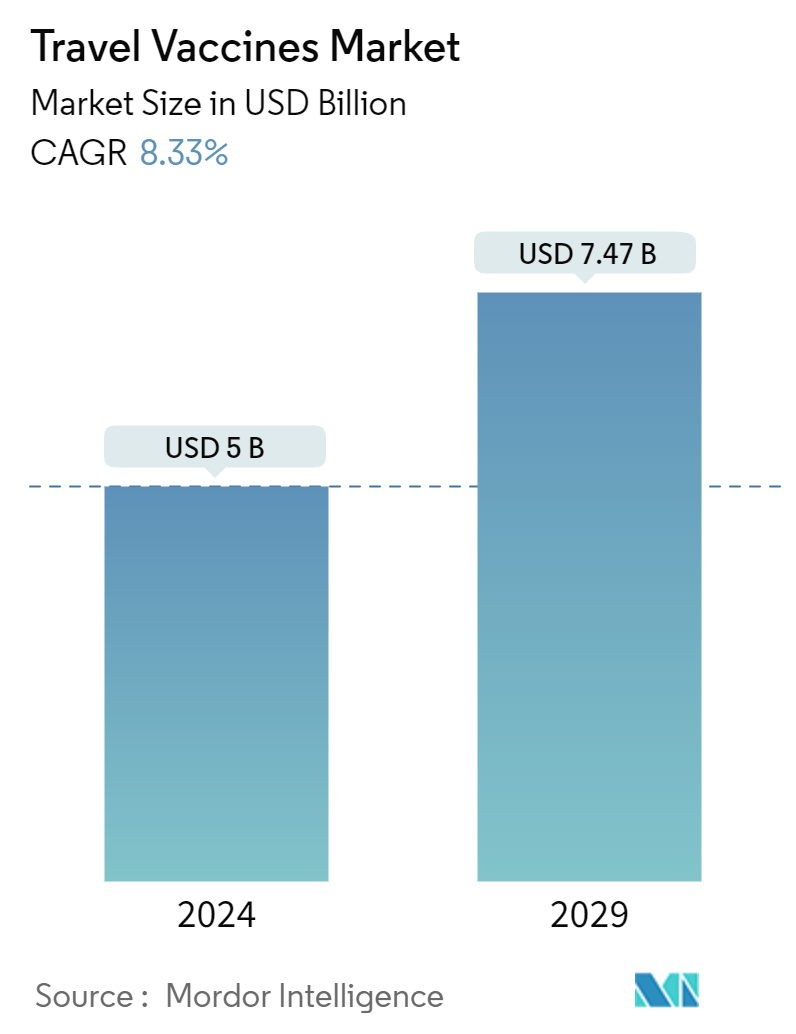Market Size of Travel Vaccines Industry

| Study Period | 2019 - 2029 |
| Market Size (2024) | USD 5 Billion |
| Market Size (2029) | USD 7.47 Billion |
| CAGR (2024 - 2029) | 8.33 % |
| Fastest Growing Market | Asia Pacific |
| Largest Market | North America |
Major Players
*Disclaimer: Major Players sorted in no particular order |
Travel Vaccines Market Analysis
The Travel Vaccines Market size is estimated at USD 5 billion in 2024, and is expected to reach USD 7.47 billion by 2029, growing at a CAGR of 8.33% during the forecast period (2024-2029).
Travel vaccination is the administration of agent-specific but safe antigenic components for the prevalent diseases at the traveler's destination. Vaccinated individuals can develop immunity against the corresponding infectious agent and thus remain protected.
Before departure, the World Health Organization (WHO) recommends that travelers have a medical consultation to learn about the disease risk in the destinations they plan to visit and the steps to avert illness. Such vaccinations are recommended to shield the traveler from the diseases prevalent in the country of origin or destination. They aim to protect travelers and avoid spreading disease within and between countries. Additionally, some countries need proof of vaccination for travelers wanting to enter or exit the country. Proof of vaccination for traveling is defined as a vaccination requirement in accordance with the International Health Regulations (IHR) of the WHO. Such guidelines and policies have raised awareness among travelers, prompting the growth of the travel vaccines market.
Furthermore, after the COVID-19 pandemic, inbound tourism witnessed a significant uptick from most revered travel destinations. For instance, as per data from the United Nations World Tourism Organization (UNWTO), Italy witnessed 74.32 million tourist arrivals in 2022, compared to 40.19 million in 2021 and 38.42 million in 2020. Similarly, Türkiye recorded 51.39 million tourist arrivals in 2022, compared to 15.97 million in 2020. Hence, such a rise in outbound tourism positively impacts demand for travel vaccines and is projected to drive market growth over the next few years.
In addition, meetings, incentives, conferences, and exhibitions (MICE) tourism is witnessing strong growth across different nations. For instance, in October 2023, the Thailand Convention and Exhibition Bureau (TCEB) unveiled its strategic direction for 2024 to transform the country’s MICE industry. Similarly, the Indian Ministry of Tourism unveiled the National Strategy and Roadmap for the MICE industry in June 2021 to promote MICE tourism in India. According to the Confederation of Indian Industry (CII), the exhibition industry in the country is rapidly growing at a rate of more than 8% and is outpacing the GDP growth rate of the country. Such initiatives are expected to increase MICE-related travel to these destinations from various countries, prompting the requirement for travel vaccines. Such factors are expected to boost the growth of the travel vaccines market.
However, most travelers from developing nations have limited awareness about travel vaccines despite constituting a large share of global outbound tourism. Such factors may restrain market growth.
Travel Vaccines Industry Segmentation
Vaccinations are a critical component in the travel medicine industry. Beyond the protection of travelers, vaccines are administered to stop the introduction of vaccine-preventable diseases at home and their destination. The WHO endorses internationally recognized certificates with proof of poliomyelitis vaccination in certain circumstances, proof of yellow fever vaccination for entry into certain countries, and proof of meningococcal vaccination for Hajj pilgrims.
The travel vaccines market is segmented by type, travel type, vaccination center, and geography. By type, the market is segmented into cholera, diphtheria pertussis tetanus (DPT), encephalitis, hepatitis A, meningococcal, rabies, typhoid, yellow fever, and other types. Based on travel type, the market is bifurcated into domestic and outbound. The travel vaccines market is segmented by vaccination centers into hospitals, travel clinics, and other vaccination centers. By geography, the market is segmented into North America, Europe, Asia-Pacific, South America, and Middle East and Africa. For each segment, the market size and forecast are provided in terms of value (USD).
| By Type | |
| Cholera | |
| Diptheria Pertussis Tetanus (DPT) | |
| Encephalitis | |
| Hepatitis A | |
| Meningococcal | |
| Rabies | |
| Typhoid | |
| Yellow Fever | |
| Other Types |
| By Travel Type | |
| Domestic | |
| Outbound |
| By Vaccination Center | |
| Hospitals | |
| Travel Clinics | |
| Other Vaccination Centers |
| Geography | ||||||||
| ||||||||
| ||||||||
| ||||||||
| ||||||||
|
Travel Vaccines Market Size Summary
The travel vaccines market is poised for significant growth, driven by increasing awareness and regulatory requirements for vaccinations before international travel. As travelers seek protection against diseases prevalent in their destinations, the demand for travel vaccines is expected to rise. This growth is further fueled by the resurgence of inbound tourism post-COVID-19, with countries like Italy and Türkiye experiencing a surge in tourist arrivals. The expansion of MICE tourism, supported by strategic initiatives in countries such as Thailand and India, also contributes to the growing need for travel vaccines. However, limited awareness among travelers from developing nations poses a challenge to market expansion.
North America is anticipated to lead the travel vaccines market, supported by robust healthcare infrastructure and regulatory frameworks. The region's residents, particularly from the United States, are frequent international travelers, boosting the demand for vaccines. Strategic partnerships and expansions by key players, such as ByoRNA SAS and Dyadic International Inc., are expected to create further growth opportunities. The market remains fragmented, with several global and regional companies like Abbott Laboratories, AstraZeneca plc, and Pfizer Inc. holding significant shares. Recent developments, such as mandatory vaccinations for pilgrims in the UAE and the acquisition of travel vaccine portfolios by Bavarian Nordic, highlight the dynamic nature of the market.
Travel Vaccines Market Size - Table of Contents
-
1. MARKET DYNAMICS
-
1.1 Market Overview
-
1.2 Market Drivers
-
1.2.1 Significant Rise in Outbound Tourism
-
1.2.2 Prevalence of Hepatitis A Across Most Travelled Destinations
-
1.2.3 Increasing Meetings, Incentives, Conferences, and Exhibitions (MICE) in Different Nations
-
-
1.3 Market Restraints
-
1.3.1 Lack of Knowledge Among Travellers from Developing Nations
-
-
1.4 Porter's Five Force Analysis
-
1.4.1 Threat of New Entrants
-
1.4.2 Bargaining Power of Buyers/Consumers
-
1.4.3 Bargaining Power of Suppliers
-
1.4.4 Threat of Substitute Products
-
1.4.5 Intensity of Competitive Rivalry
-
-
-
2. MARKET SEGMENTATION (Market Size by Value - USD)
-
2.1 By Type
-
2.1.1 Cholera
-
2.1.2 Diptheria Pertussis Tetanus (DPT)
-
2.1.3 Encephalitis
-
2.1.4 Hepatitis A
-
2.1.5 Meningococcal
-
2.1.6 Rabies
-
2.1.7 Typhoid
-
2.1.8 Yellow Fever
-
2.1.9 Other Types
-
-
2.2 By Travel Type
-
2.2.1 Domestic
-
2.2.2 Outbound
-
-
2.3 By Vaccination Center
-
2.3.1 Hospitals
-
2.3.2 Travel Clinics
-
2.3.3 Other Vaccination Centers
-
-
2.4 Geography
-
2.4.1 North America
-
2.4.1.1 United States
-
2.4.1.2 Canada
-
2.4.1.3 Mexico
-
-
2.4.2 Europe
-
2.4.2.1 Germany
-
2.4.2.2 United Kingdom
-
2.4.2.3 France
-
2.4.2.4 Italy
-
2.4.2.5 Spain
-
2.4.2.6 Rest of Europe
-
-
2.4.3 Asia-Pacific
-
2.4.3.1 China
-
2.4.3.2 Japan
-
2.4.3.3 India
-
2.4.3.4 Australia
-
2.4.3.5 South Korea
-
2.4.3.6 Rest of Asia-Pacific
-
-
2.4.4 Middle East and Africa
-
2.4.4.1 GCC
-
2.4.4.2 South Africa
-
2.4.4.3 Rest of Middle East and Africa
-
-
2.4.5 South America
-
2.4.5.1 Brazil
-
2.4.5.2 Argentina
-
2.4.5.3 Rest of South America
-
-
-
Travel Vaccines Market Size FAQs
How big is the Travel Vaccines Market?
The Travel Vaccines Market size is expected to reach USD 5 billion in 2024 and grow at a CAGR of 8.33% to reach USD 7.47 billion by 2029.
What is the current Travel Vaccines Market size?
In 2024, the Travel Vaccines Market size is expected to reach USD 5 billion.

